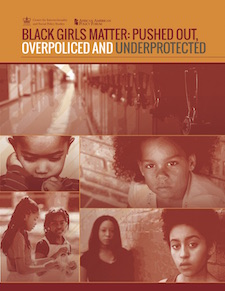 A new study by the African American Policy Forum and the Center for Intersectionality and Social Policy Studies at Columbia Law School finds that Black girls face significantly higher levels of harsh punishment in schools than their White peers. And the study finds that little is being done to address the school-to-prison pipeline for young Black girls, while considerable attention is paid to the school-to-prison pipeline as it impacts young Black males.
A new study by the African American Policy Forum and the Center for Intersectionality and Social Policy Studies at Columbia Law School finds that Black girls face significantly higher levels of harsh punishment in schools than their White peers. And the study finds that little is being done to address the school-to-prison pipeline for young Black girls, while considerable attention is paid to the school-to-prison pipeline as it impacts young Black males.
According to the most recent data from the U.S. Department of Education cited in the report, nationally Black girls were suspended six times more than White girls, while Black boys were suspended three times as often as White boys. Rates of expulsion were even more strikingly disproportionate between Black and White students, especially among girls.
 Kimberle W. Crenshaw, a professor of law at Columbia University and a professor of law at the University of California, Los Angeles and the lead author of the report, states that “as public concern mounts for the needs of men and boys of color through initiatives like the White House’s My Brother’s Keeper, we must challenge the assumption that the lives of girls and women—who are often left out of the national conversation—are not also at risk.”
Kimberle W. Crenshaw, a professor of law at Columbia University and a professor of law at the University of California, Los Angeles and the lead author of the report, states that “as public concern mounts for the needs of men and boys of color through initiatives like the White House’s My Brother’s Keeper, we must challenge the assumption that the lives of girls and women—who are often left out of the national conversation—are not also at risk.”
Professor Crenshaw is a graduate of Cornell University and Harvard Law School. She earned a master’s degree in law at the University of Wisconsin.
The full report, Black Girls Matter: Pushed Out, Overpoliced and Underprotected, may be downloaded by clicking here.











The finding of this study that relative differences in suspension rates were larger for girls than for boys, as well as the finding that racial disproportionality was more striking for expulsions and suspensions, should hardly be surprising. Both findings are to be expected because of the pattern whereby the rarer the outcome the greater tends to be the relative difference in experiencing it and the smaller tends to be the relative difference in avoiding it. Inasmuch as girls are suspended far less frequently than boys, one will commonly find larger relative differences in suspension rates, though smaller relative differences in rates of avoiding suspension, among girls than than among boys. The situation may be compared to the larger relative racial differences in suspension rates, though smaller relative differences in avoiding suspensions, among pre-school students than K-12 students shown in Table 8 of reference 1.
Similarly, because expulsions are rarer than suspensions, relative differences in rates of experiencing the outcome tend to be larger, though relative differences in rates of avoiding the outcome tend to be smaller, for expulsions than suspensions. See Table 1 of reference 2 (though note the departure from the pattern with respect to girls).
The forces causing racial differences in suspension and expulsion rates may or may not be greater among girls than boys. But that determination must be based on a sound measure, such as that employed Table 8 of reference 1 and Table 1 of reference 2.
Observers must also recognize, however, that general reductions in discipline rates will tend to increase relative differences in discipline rates, as discussed in reference 1, 3 and 4, and as illustrated by the pages collected as reference 5 in the case of the various jurisdictions that have recently reduced discipline rates while mistakenly believing that doing so would reduce relative differences in discipline rates.
I also note that there is a technical problem in this report regarding the appraisal of discipline disparities in Boston and New York beginning at page 19. The beginning of the discussion make it clear enough that in statements such as black girls “were eleven times more subjected to discipline than their white counterparts” the ratio was based on the number of blacks disciplined divided by the number of whites disciplined in contexts where there were substantially more black students than white students. But the report then goes on to treat the ratios as if they were ratios of discipline rates. But, for example, where there are three times as many black girls as white girls, but the number of black suspensions is eleven times the number of whites, the ratio of the black suspension rate to the white suspension rate would be 3.7 not 11. Thus, readers may mistakenly believe that the Boston and New York ratios in Figure 5 are substantially out of line with the national ratios shown in Figure 1. In noting this problem, however, I do not mean to suggest that the rate ratio is a sound measure of association. See reference 1.
1. “Race and Mortality Revisited,” Society (July/Aug. 2014)
http://jpscanlan.com/images/Race_and_Mortality_Revisited.pdf
2. Discipline Disparities page of jpscanlan.com
http://jpscanlan.com/disciplinedisparities.html
3. 1. “Things government doesn’t know about racial disparities,” The Hill (Jan. 28, 2014).
http://thehill.com/blogs/congress-blog/civil-rights/196543-things-the-legislative-and-executive-branches-dont-know
4. “The Paradox of Lowering Standards,” Baltimore Sun (Aug. 5, 2013)
http://jpscanlan.com/images/Paradox_of_Lowering_Standards.pdf
5. http://jpscanlan.com/disciplinedisparities/losangelesswpbs.html
http://jpscanlan.com/disciplinedisparities/marylanddisparities.html
http://jpscanlan.com/disciplinedisparities/denverdisparities.html
http://jpscanlan.com/disciplinedisparities/minneapolisdisparities.html
http://jpscanlan.com/disciplinedisparities/stpauldisparities.html
http://jpscanlan.com/disciplinedisparities/beavertondisparities.html
http://jpscanlan.com/disciplinedisparities/montgomerycountydisp.html
http://jpscanlan.com/disciplinedisparities/henricocountydisparitie.html
http://jpscanlan.com/disciplinedisparities/portlanddisparities.html
http://jpscanlan.com/disciplinedisparities/minnesotadisparities.html
http://jpscanlan.com/disciplinedisparities/connecticutdisparities.html
http://jpscanlan.com/disciplinedisparities/rhodeislanddisparities.html